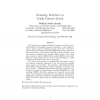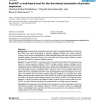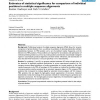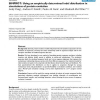40 search results - page 3 / 8 » On single and multiple models of protein families for the de... |
JCB
1998
13 years 6 months ago
1998
The function of an unknown biological sequence can often be accurately inferred by identifying sequences homologous to the original sequence. Given a query set of known homologs, ...
BMCBI
2006
13 years 6 months ago
2006
Background: The functional annotation of proteins relies on published information concerning their close and remote homologues in sequence databases. Evidence for remote sequence ...
BMCBI
2011
13 years 1 months ago
2011
Background: Remote homology detection is a hard computational problem. Most approaches have trained computational models by using either full protein sequences or multiple sequenc...
BMCBI
2004
13 years 6 months ago
2004
Background: Profile-based analysis of multiple sequence alignments (MSA) allows for accurate comparison of protein families. Here, we address the problems of detecting statistical...
BMCBI
2005
13 years 6 months ago
2005
Background: General protein evolution models help determine the baseline expectations for the evolution of sequences, and they have been extensively useful in sequence analysis an...




